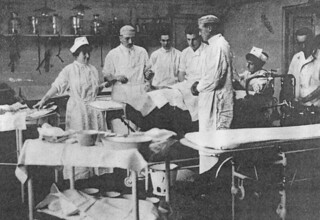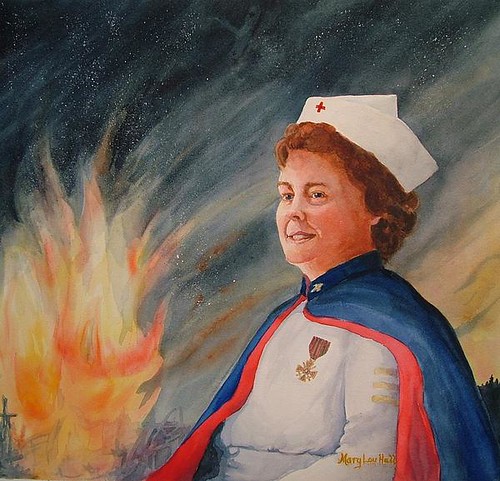Story by John Trowbridge, Kentucky National Guard Command Historian
In recognition of March as Women's Month, kentuckyguard.com is publishing a series of articles honoring women who are significant figures in Kentucky’s military history. The following is one such story ….
 FRANKFORT, Ky.
FRANKFORT, Ky. -- Margaret Willie Arvin was born on April 21, 1879, the oldest of seven children of William and Bettie Arvin, of Henderson, Kentucky. Not much is known about her early years. In 1904, she graduated from the School of Nursing at the Owensboro City Hospital in Owensboro, Kentucky.
In 1914, she is accepted as a member of the General Samuel Hopkins Chapter of the National Society of the Daughters of the American Revolution, in Henderson. Mary was a descendant of Revolutionary War soldiers, Lieutenant Colonel Henry Dixon and General Samuel Hopkins.
That same year, events overseas begin to happen which would change the World forever. In June 1914, the First World War erupts in Europe. The United States remains neutral until April 1917. That same month The Harvard Unit, Base Hospital No. 5 is ordered to prepare for immediate mobilization. The hospital is comprised of doctors and nurses from the Harvard University Hospital, in Boston, Massachusetts. It was one of six Red Cross hospitals organized for Army service. By June 1917 the unit was assigned to support the British Expeditionary Forces in France.
[caption id="" align="alignleft" width="320"]

Nurses quarters Base Hospital No. 5.
Back in the United States, on June 11, 1917, Nurse Mary Arvin decided to join the war effort. She joined the American Red Cross and was assigned to Base Hospital Number 5. Arvin was immediately sent overseas to join the unit in France on July 18, 1917.
Nurse Arvin’s tour of duty was far from boring. From her nursing duties, seeing the sights of France, meeting people from different countries, social events, and due to the fact that their hospital was supporting the British Army, visits from members of the British Royal family.
However all this would change on the evening of September 4, 1917, when the hospital came under attack. During a night bombing raid by the Germans, the first American battlefield casualties of the First World War were members of Base Hospital No. 5. The next day Nurse Arvin writes home to tell of the attack on the hospital.
“The Lord was certainly with us. While there were a number of our patients wounded from the bombs, our adjutant and three of our American boys were killed, and several wounded. There was not a nurse hurt, so I think we escaped very lucky. It was a beautiful moon light night about 11:30. I was sitting here in my ward at the table when I heard, oh, such loud reports, one right after the other. It shocked me so that it knocked me out of my chair. One of my patients hollowed to me, saying: ‘Sister, lie flat on the floor.’ I said, ‘No, I must go over to the other ward and see if any of the patients are hurt there.’
“Just as I started to cross over I looked up and saw the aeroplane crossing very peacefully over. I thought to myself, oh, if I just had a big gun, you would never know what happened to you. There were five or six bombs dropped altogether in different places. I saved a piece of the shrapnel as a souvenir.”
On June 30, 1918, Base Hospital No. 5 was once again the target of a German night bombing mission. In a letter home she describes some of what occurred during the raid: “I do not know whether or not this will pass the censor, but the very night that we had our dinner, after we had returned to the hut, we were raided. I cannot tell you about it, but you can image the rest. No one in the unit was injured. Oh, how I would love to tell you everything. The next night the colonel came to me and said that I was the heroine’ and was to be decorated with a medal. They tell me that my name will also be put in the dispatches. I told the colonel I didn’t deserve all the credit, I only did my duty, stuck with my patients, kept them under control and tried hard to keep cool and to keep my head. I didn’t for a minute let them know I was frightened. I don’t think I could have managed them if I had. It tore things up considerably, but thank heaven not one of my patients was injured, only a few scratches.”
[caption id="" align="alignright" width="320"]

Base Hospital #5 operating room.
Within a few days Nurse Arvin was awarded the French Cross of War and had received official congratulatory letters from General Pershing and her chain of command.
In his letter, General Pershing wrote, “My Dear Miss Arvin: Please accept my heartiest congratulations and sincere appreciation of the fine work you did on the night of June 30, 1918, when your hospital was a target of German airplane bombs. Your presence of mind and courage in quieting your patients was, under the circumstances, deserving of the highest praise. I am proud to have in the American Expeditionary Forces a nurse whose devotion to duty is of such high character as yours.”
On November 11, 1918, the War to end all wars came to a close. On January 20, 1919, Base Hospital No. 5 was relived from duty with the British Army. Elements began to filter back to the United States, and by late March, Nurse Arvin arrived back home in Henderson. The local newspapers ran a couple articles about her service and she became the guest speaker at a number of local social gatherings. In April she received the U. S. Army’s citation for exceptionally meritorious and conspicuous service, signed by General John “Black Jack” Pershing.
Over the next few months Nurse Arvin settled back into her civilian nursing career, in October she was assigned as a Red Cross welfare worker in Hopkinsville, Kentucky.
In November, she was notified that the British Government had awarded her the British Royal Red Cross Medal. At a ceremony held in Washington D. C. on November 13, 1919, Nurse Arvin received her medal from Prince Edward, who would later become King Edward of England. Nurse Arvin is one of few American women who served in the First World War to be recognized by all three of the major allied countries, France, Britain and the United States.
[caption id="" align="alignright" width="400"]

In March 2006, Nurse Mary Arvin was honored by the Kentucky Women Remembered program and her portrait was framed and hung in the State capitol in Frankfort.
In a 1920 book published by members of Base Hospital 5, they make mention of Nurse Arvin in a poem:
There has been in our midst, since we’ve been to France,
A nice quiet lady named Arvin;
But as she don’t sing or dance, we have not had a chance,
To find what she really excels in.
The book also states the fact that she was known as “Bill,” by members of the unit, due to her middle name of Willie.
Sometime between 1921 and 1925, Nurse Arvin moved from Kentucky to Orlando, Florida where she worked as a private nurse and then in the local hospital. On March 28, 1925, she married William Tiller. Tiller a native of Georgia and himself a World War One veteran was a realtor in Orlando. Within a year of their marriage William Tiller dies leaving Mary a widow.
In 1932, she marries a second time, Robert Sissons, another veteran of the war, working as an office manager for an automobile firm in Orlando. This second marriage would last fourteen years, until the death of Mr. Sissons in 1946.
In February, 1932, The War Department made the announcement of a new medal, “The Purple Heart Medal.” Today that medal is recognized as being awarded to individuals who sustain a wound in combat, however, originally, it was awarded to individuals for military merit. World War One veterans that had received the Meritorious Service Citation, signed by General Pershing, were entitled to turn-in their citation and be awarded the new medal. Nurse Arvin turned-in her citation and was awarded the Purple Heart Medal, becoming one of the first females in U. S. Military history to receive the Purple Heart Medal.
Nurse Mary Arvin died on September 9, 1947, while visiting her sister in Henderson. She was laid to rest under full military honors conducted by the local American Legion Post in the Fernwood Cemetery in her home town of Henderson.
In March 2006, she was honored by the Kentucky Women Remembered program, her portrait and story are beautifully framed and hangs in the State Capitol in Frankfort.
In 2010, a Kentucky historical marker, was dedicated near her grave in the Fernwood Cemetery which tells her story of her service, sacrifice and dedication to duty.